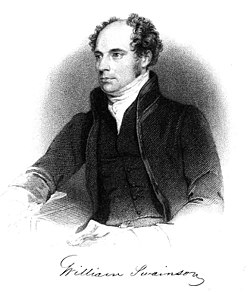William Swainson
William Swainson, Fellow of the Linnean Society and Fellow of the Royal Society (8 October 1789 – 6 December 1855), was an English ornithologist, malacologist, entomologist and artist.
William Swainson | |
|---|---|
 | |
| Born | 8 October 1789 St. Mary Newington, London, United Kingdom |
| Died | 6 December 1855 (aged 66) Fern Grove, Hutt Valley, New Zealand |
| Citizenship | United Kingdom |
| Scientific career | |
| Fields | Ornithology, malacology, entomology, natural history |
Life
Swainson was born in Dover Place, St. Mary Newington, London. He was the eldest son of John Timothy Swainson, who was also of the Linnean Society.[1] William worked at the Liverpool Customs when he was 14.[2] He studied the ichthyology of western Sicily. In 1815, he returned to England because he became ill.
In 1816 he went with the explorer Henry Koster to Brazil. They did not spend a long time on shore because of a revolution. However, Swainson brought to England over 20,000 insects, 1,200 species of plants, drawings of 120 species of fish, and about 760 bird skins.
As with many Victorian scientists, Swainson was also a member of many societies. He was elected as a fellow to the Royal Society after his return from Brazil on 14 December 1820.[2][3] In 1823, he married his first wife Mary Parkes, and had four sons and a daughter. His wife died in 1835.
Swainson re-married in 1840 to Ann Grasby, and emigrated to New Zealand in 1841. He died at Fern Grove, Lower Hutt, New Zealand, on 7 December 1855.
Species named after William Swainson
Many birds were named after William Swainson.
- John James Audubon named Swainson's Warbler Limnothlypis swainsonii
- Charles Lucien Bonaparte named Swainson's Hawk Buteo swainsoni
- Thomas Nuttall named Swainson's Thrush Catharus ustulatus
- Swainson's Francolin Francolinus swainsonii
- Swainson's Sparrow Passer swainsonii
- Swainson's Antcatcher Myrmeciza longipes
- Swainson's Fire-eye Pyriglena atra
- Swainson's Flycatcher Myiarchus swainsoni
- Swainson's Toucan Ramphastos swainsonii
William Swainson Media
In this Zoological Illustrations lithograph Swainson depicted Urania sloanus, a now extinct species.
Image of a colour lithograph of a Moluccan king parrot produced by Swainson in the first volume of Zoological Illustrations
References
- ↑ Biographical Etymology of Marine Organism Names. L
- ↑ 2.0 2.1 "William Swainson F.R.S, F.L.S., Naturalist and Artist: Diaries 1808-1838:Sicily, Malta, Greece, Italy and Brazil." G.M. Swainson, Palmerston, NZ 1989.
- ↑ Election of William Swainson as a Fellow of the Royal Society[dead link]





